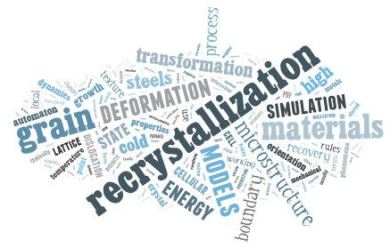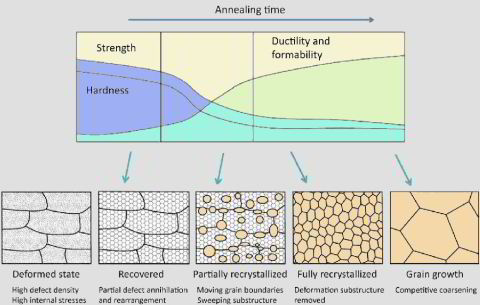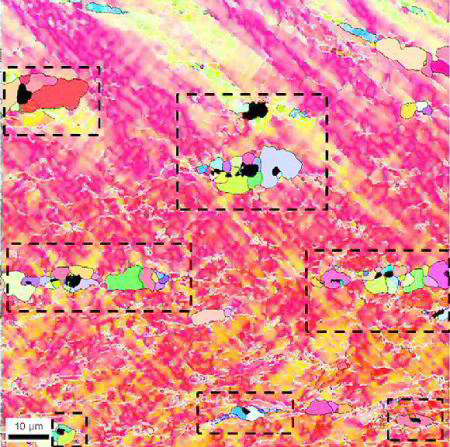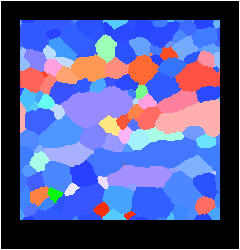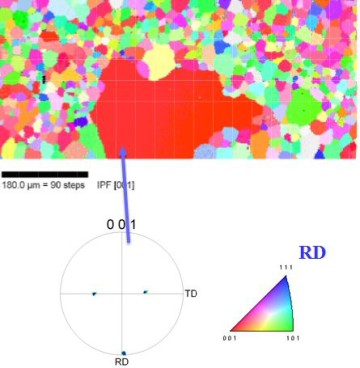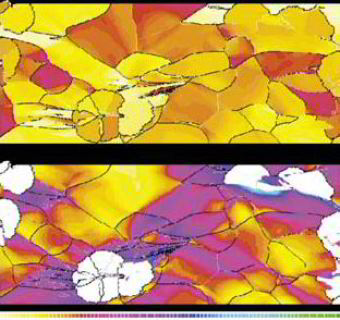Simulation and grain growth: basic phenomena and simulation methods
Introduction to basic recrystallization phenomena
Discrete Simulation methods for recrystallization and grain growth
The cellular automaton model in materials science
Examples of recrystallization and growth simulations
Simulation of recrystallization and phase transformation
Reprints on simulation of recrystallization
Raabe, D.
Multiscale recrystallization models for the prediction of crystallographic textures with respect to process simulation
(2007) Journal of Strain Analysis for Engineering Design, 42 (4), pp. 253-268.
Overview Multiscale recrystallization mo[...]
PDF-Dokument [688.3 KB]
This paper discusses the most relevant multiscale models for predicting crystallographic textures formed during the primary static recrystallization of metals. Two main groups of
approaches are presented, namely those which spatially discretize the grains and the interface motion associated with recrystallization and those which treat these phenomena in an
Avrami-type statistical fashion. The article gives a concise review of the methods, placing
particular attention on their strengths and weaknesses in the context of process modelling, of conceptual aspects, and of the data sets required as input for practically applying the
models to the prediction of crystallographic textures in the course of metallurgical processes.
Computational Materials Science 34 (2005) 299–313
Dierk Raabe, Luc Hantcherli
2D cellular automaton simulation of the recrystallization texture of an IF sheet steel under
consideration of Zener pinning
Comput Mater Sc Vol 34 (2005) 299 pinnin[...]
PDF-Dokument [1.3 MB]
The understanding of the recrystallization texture of interstitial free (IF) low carbon steel sheets is important for an improved prediction of the resulting elastic-plastic anisotropy of such
steels with respect to their engineering performance during sheet forming in the automotive industry. The main goal in that context is to produce IF steel sheets with a very strong and homogeneous
c-fiber texture ({111} texture) and a very small orientation density of the 45° ND-rotated cube orientation, {001}<110> (ND refers to the sheet normal direction). The beneficial mechanical
properties resulting from such textures, namely, a maximum planar Lankfort value together with a minimum variation of the Lankfort value in the sheet plane, define the goal for optimizing
corresponding industry- scale continuous annealing procedures for IF steels for better sheet drawability. An important microstructural parameter affecting the formation of recrystallization textures
in IF steels is the influence of incoherent second phase precipitates which are located on the inherited grain boundaries of the deformed grains (e.g., aluminium- nitrides, titanium-carbides,
titanium-sulfides, titanium-carbonitrides). In this study we use a modified 2D cellular automaton approach for the simulation of primary static recrystallization of a cold rolled IF sheet steel (75%
engineering thickness reduction). The proposed modification of the automaton consists in the possibility to consider the pinning effect associated with particles at the former grain boundaries
according to the Zener or respectively Zener–Friedel models.
More specific this paper presents a 2D cellular automaton simulation study on the evolution of the recrystallization texture in a 75% cold rolled interstitial free (IF) sheet steel. The model is
applied to experimentally obtained high resolution microtexture EBSD data. The simulation is discrete in time and physical space. Orientation is treated as a continuous variable in Euler space. The
dislocation density distribution is approximated from the Kikuchi pattern quality of the experimental EBSD data. It is used for the calculation of the scalar driving force field required for the
recrystallization simulation. Different models for nucleation and for the influence of Zener-type particle pinning are presented and tested. Real time and space calibration of the simulation is
obtained by using experimental input data for the grain boundary mobility, the driving forces, and the length scale of the deformed microstructure as mapped by the high resolution EBSD experiments.
The simulations predict the kinetics and the evolution of microstructure and texture during recrystallization. Depending on the ratio of the precipitated volume fraction and the average radius of the
particles the simulations reveal three different regimes for the influence of particle pinning on the resulting microstructures, kinetics and crystallographic textures.
The concurrent ferrite recrystallization and austenitic transformation during intercritical annealing of cold-rolled DP steels is investigated by cellular automaton (CA) modeling. The simulations provide insight into the microstructural phenomena that result from the interaction of primary recrystallization and phase transformation. We find that the interaction between ferrite recrystallization and austenite formation affects not only the transformation kinetics but also the morphology and spatial distribution of the austenite. From this we can interpret experimental data of the observed temperature-dependent hardness and its dependence on the two metallurgical processes. The influence of the initial heating rate on subsequent isothermal transformation kinetics and the microstructure evolu
Acta-Materialia-2013-recrystallization a[...]
PDF-Dokument [6.1 MB]

